This pair flew 172 hours, 32 minutes straight in the sky over Fort Worth in 1929. Why?
- Oops!Something went wrong.Please try again later.
Our Uniquely Fort Worth stories celebrate what we love most about Cowtown, its history & culture. Story suggestion? Editors@star-telegram.com.
A series of developments in the 1920s put Fort Worth on the cutting edge of aviation: creating one of the first airlines (Southern Air Transport), inaugurating the first scheduled passenger service in the Southwest, being a stop on the first “powder puff” air race, and being home to a dirigible refueling base.
In 1929, that same pioneering spirit drove a couple of Fort Worth flyers, Reg Robinson and James Kelly, to set a world endurance record for time in the air: 172 hours, 32 minutes. Take that, Charles Lindbergh! Their historic flight started at Meacham Field on Sunday, May 19, at 11:33 am, and they circled the city until landing triumphantly at 4:05 pm on May 27 — a total of eight uninterrupted days in the air.
They not only broke the previous record of 150 hours, 40 minutes, set by U.S. Army Air Corps pilots, they also shattered the record of Germany’s Graf Zepplin dirigible. No one had ever spent that much time in the air.
Twenty-six-year-old Reginald L. Robbins and 23-year-old James Kelly were partners of convenience. Robbins was an old-fashioned daredevil whose day job was railroad mechanic. After World War I he bought a surplus airplane and took up barnstorming, which meant flying from one small town to another taking the locals up – pretty girls for free, others for a price. In May 1929 he was married and had a 6-year-old son.
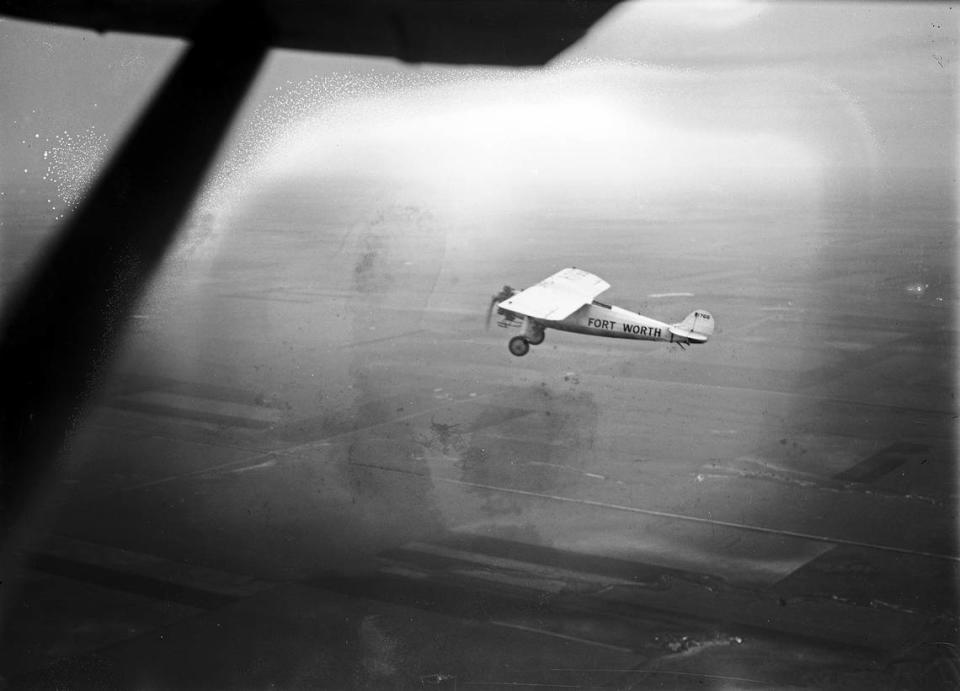
Kelly was a recent acquaintance and a new husband, having married just six weeks before. He was known as “Cowboy” because before taking up flying only a year earlier he was a cowhand on an east Texas ranch. He gave up his horse to move to Fort Worth and enroll in flying school. Nine months later he had his pilot’s license.
It was Robbins’ dream to break the existing flight record. Neither man had much money, and the project would require a deep-pocketed investor. The Army’s record had been set by a five-man crew flying a trimotor monoplane with the financial backing of the War Department. Robbins and Kelly finally found a backer in the Texas and Pacific Coal and Oil Company, which agreed to furnish all the oil and gasoline they would need at no cost. It would be good public relations.
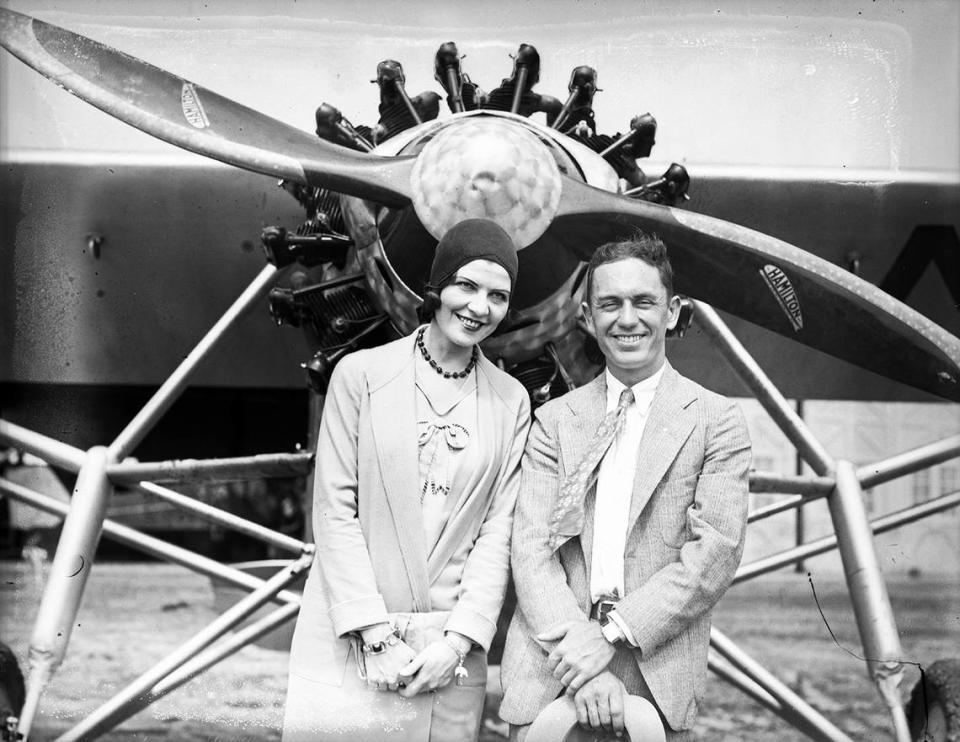
The plane they flew was a second-hand Ryan monoplane. (At this time most private pilots were still flying biplanes.) It was the same kind of plane flown by Charles Lindbergh in his historic flight across the Atlantic two years earlier. It was powered by a Whitney Whirlwind engine rebuilt by Robbins. They named their plane “Fort Worth” in honor of their hometown.
They customized the plane for the mission by installing additional gas tanks and building a catwalk under the nose to service the engine in-flight. They also installed a special instrument to keep track of their altitude for record-setting purposes. (It would show they hadn’t secretly landed somewhere in the night). Their average speed during their 172½ hours in the air was 65 mph.
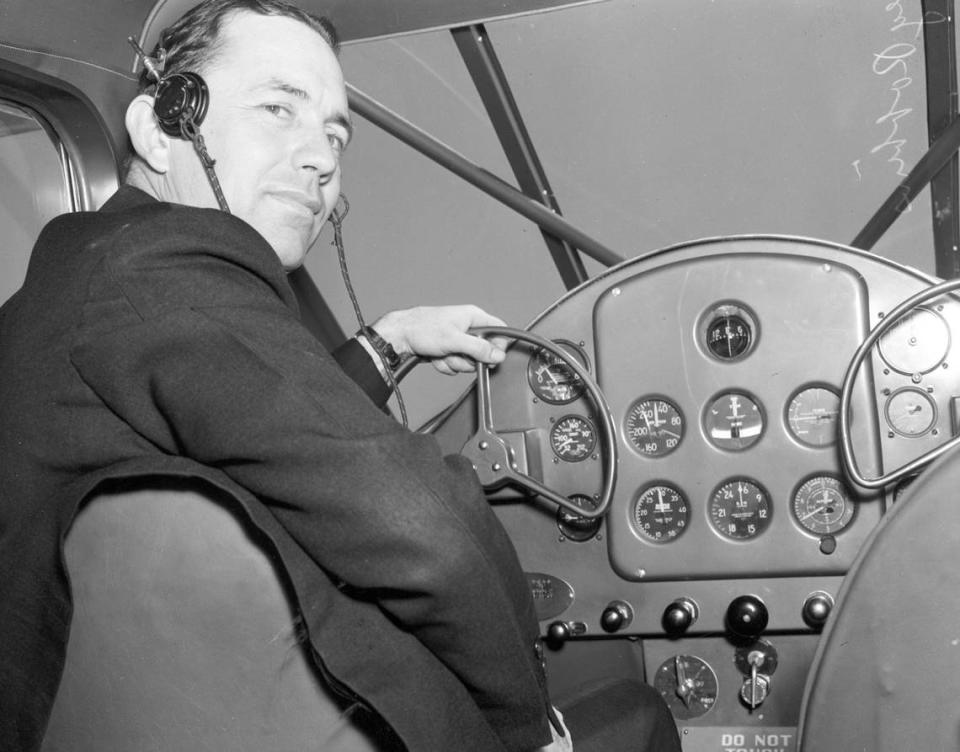
The trickiest part was not flying the plane but refueling it and lubricating the engine in mid-air. They accomplished the former with a primitive version of the technique adopted by the U.S. Air Force after World War II to fly vast distances over oceans and hostile territory. In its primitive form it consisted of lowering a 27-foot rubber hose from a fuel plane to a port on the top of the “Fort Worth,” then while the pilots of both planes kept their aircraft steady, the fuel filled their tanks. This process had to be repeated 17 times during the flight.
The other harrowing job required Kelly to make his way along the catwalk to a perch just behind the propeller from where he could grease the engine’s rocker arms.
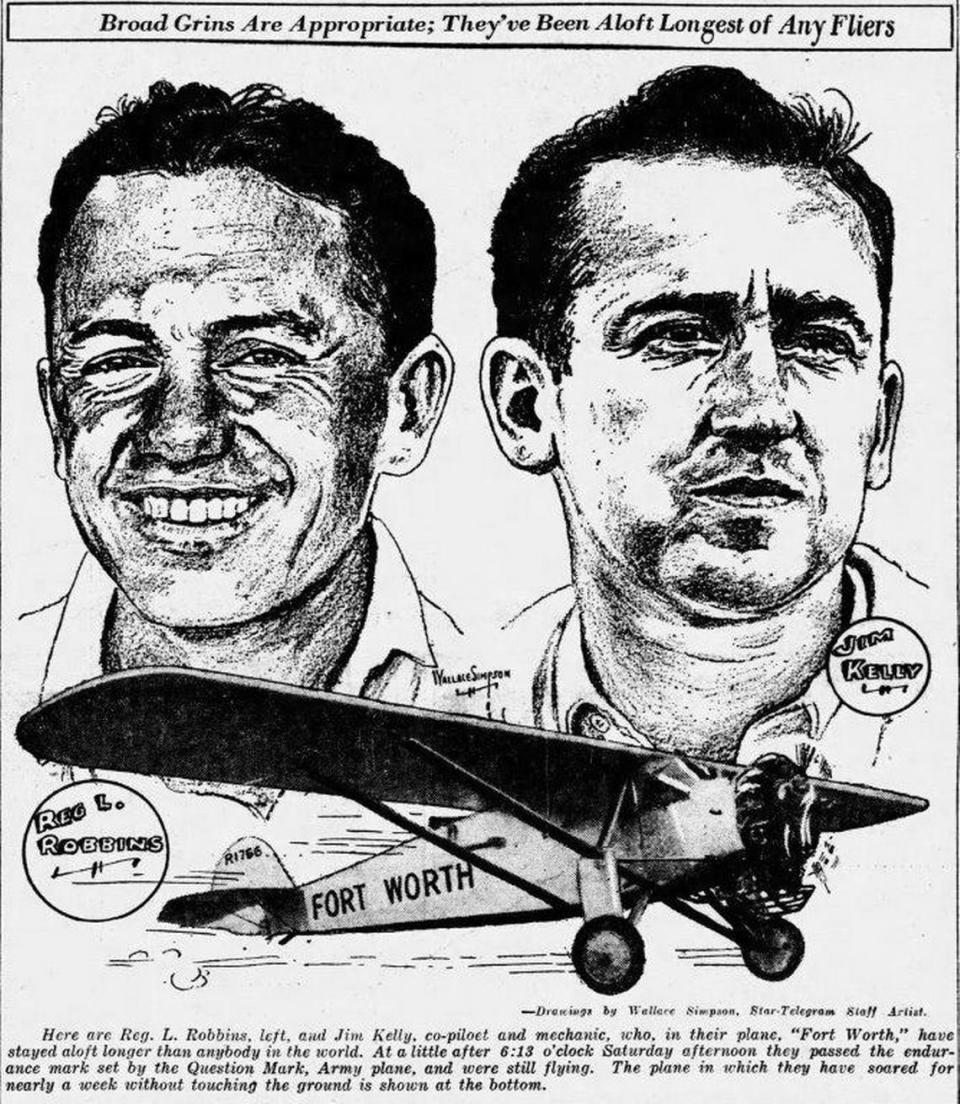
As they circled overhead day after day, crowds on the ground watched the “Fort Worth” fly into and out of sight regularly. Their quest attracted international attention; they were followed by newspapers and radio stations across America and Europe. Will Rogers in his syndicated column quipped, “Those boys have forgot how to land.”
With no radio, Robbins and Kelly had no way of knowing the world was watching. Their communication with the ground was via their wives’ handwritten notes conveyed to them in a mail pouch dangled on a line from the refueling plane. For their part, they periodically flew low enough to drop messages of their own to their wives and supporters. Mrs. Kelly dubbed these communications, “sky calls.”
The record-setting flight was a grueling experience in many ways. There was no toilet on the plane and only cold snacks for the seven days they were aloft. Toward the end of the flight the wooden propeller cracked, causing the plane to vibrate uncontrollably. By the time they landed, the two men were practically deaf. The last night in the air they also had to fly through a “blinding rain storm” that cut visibility to zero and tossed the plane about like a leaf. They took turns flying while the non-flyer snatched a few hours’ shuteye in a hammock.
The experience left both men bleary-eyed and exhausted before the end.
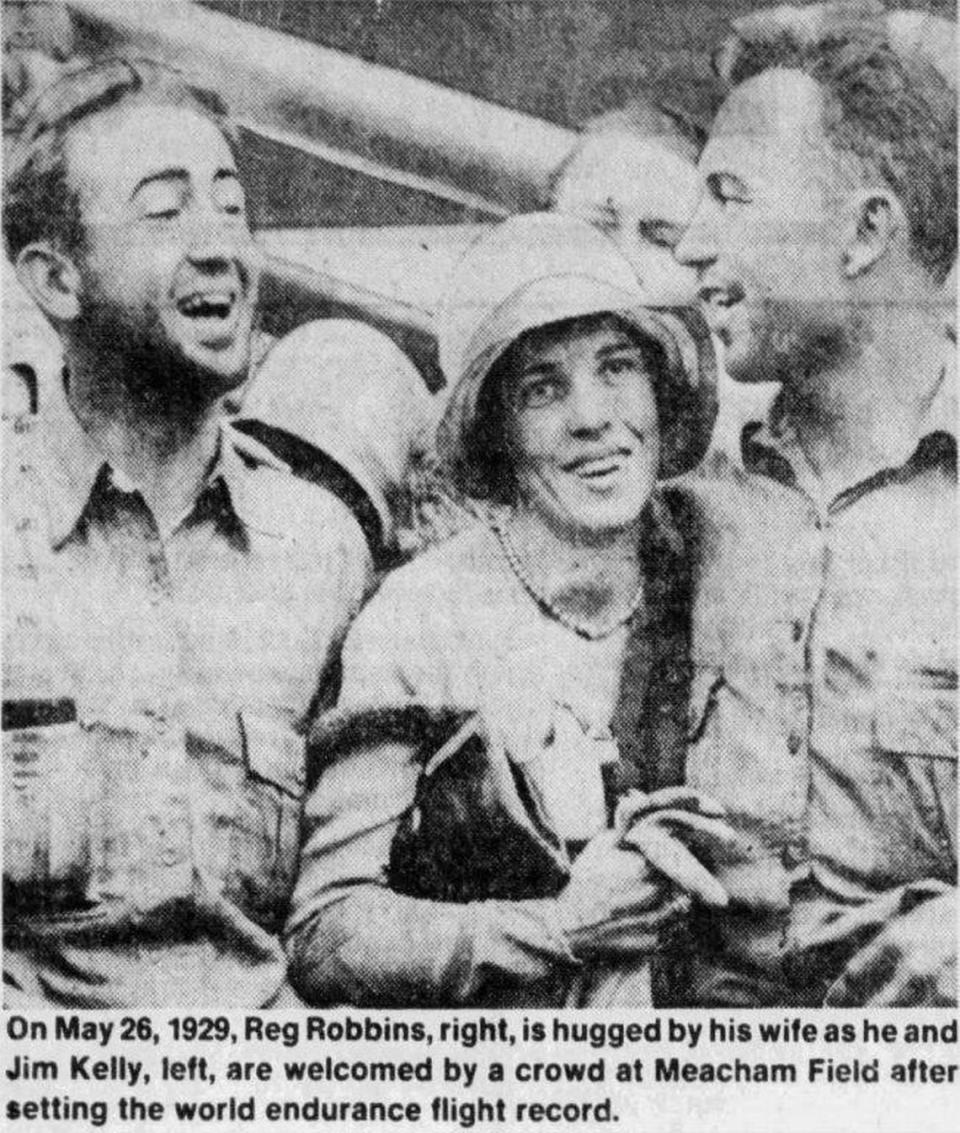
The waiting crowd at Meacham Field, estimated at more than 25,000, welcomed their hometown heroes back to terra firma with cheers. They had bested the previous world record by 22 hours. Their relieved wives were the first to greet them when they climbed out of their plane. One distinguished member of the crowd was famed British aviatrix, Lady Mary Heath who had heard of their historic flight and came to see it for herself.
The city rolled out the red carpet for them. Star-Telegram publisher Amon Carter, Fort Worth’s “Mr. Aviation,” hosted a gala victory party at the Fort Worth Club. The two celebrities weren’t even allowed to bathe and change clothes before their motorcycle-escorted trip to the club. A downtown businesses group calling themselves “Progressive Fort Worth Merchants” took out a full-page ad in the Star-Telegram congratulating them. The ad crowed that Fort Worth was “air-minded” because of its mild climate, central geographical location, and public spirit.
Both Fort Worth daily newspapers beat the drum for the record-setting accomplishment, but they were not alone. The Austin American called it “as astonishing as any chapter in American aviation.” The Tuam Herald of Ireland also sent congratulations for the Americans’ “splendid achievement,” acknowledging “the world-wide honor and renown they have brought to their native Texas and to Fort Worth.”
Nor was Texas Gov. Dan Moody remiss in recognizing the pair. He made them lieutenant colonels in the Texas National Guard attached to his personal staff.
Robbins’ and Kelly’s flight helped cement Fort Worth’s status as an early aviation center. By coincidence, the day before they landed, another Fort Worth pilot, Jimmie Mattern, took off in his rebuilt Cessna for San Antonio to enter the San Antonio-to-St. Louis trophy race.
His goal was to win the Gardner trophy and the $10,000 prize money that went with it plus “bring additional honor to Fort Worth as an aviation peer.” Borrowing from both Charles Lindbergh and Robbins and Kelly, he named his plane “Planet of Fort Worth.” It was men like these that made Fort Worth the aviation capital of the Southwest, home to Meacham municipal airport, three decommissioned World War I training fields, and several flying schools.
Robbins and Kelly not only put their names in the record books, they made a financial killing. Before they even took off, several air transport companies collectively promised them $50 apiece for every hour they spent in the air. Post flight, the Fort Worth Chamber of Commerce added to their take with $12,000 raised through subscriptions. They were also contacted by national magazines eager to pay them for their story, and vaudeville promoters offering to put them on the stage. They had become national celebrities.
Alas, their story did not have a happy ending. Jim Kelly was killed in a plane crash less than a year later while flying from Oklahoma City to Fort Worth. His plane was caught in a storm and went down near Alvord, Texas. He joined a long list of aviation pioneers who died prematurely doing what they loved, including Vernon Castle, Wiley Post, and Amelia Earhart.
Reg Robbins, the daredevil of the two, entered another endurance race in 1931 from Seattle to Tokyo with mid-air refueling. However, he had to drop out at Nome, Alaska. When not racing he ran a flying school in Fort Worth until hired as chief pilot by Brown & Root of Houston. He retired in 1976 and died in 1985.
Reg Robbins’ and James Kelly’s claim to history was overshadowed by Lindbergh’s historic flight and other events in aviation in these same years, but it deserves to be remembered for the feat it was. And it happened right here in Fort Worth.
Author-historian Richard Selcer is a Fort Worth native and proud graduate of Paschal High and TCU.

